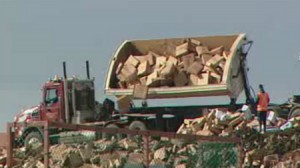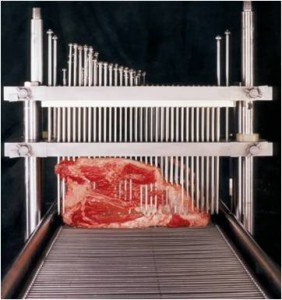Canadians can go back to sleep, the XL plant in Alberta has been cleared to reopen.
The 16 E. coli O157:H7 victims and their families may have a few more questions.
So may the rest of Canadians and anyone else concerned about two aspects of this outbreak: how do people know if beef has been needle tenderized, and should recalled  meat be dumped in a landfill or processed for further use? Oh, and whether the Canadian Food Inspection Agency does anything, with their 40 inspectors and six veterinarians in the plant. And whether XL cares about anything other than profit.
meat be dumped in a landfill or processed for further use? Oh, and whether the Canadian Food Inspection Agency does anything, with their 40 inspectors and six veterinarians in the plant. And whether XL cares about anything other than profit.
As David Acheson, former food safety guru at the U.S. Food and Drug Administration said when spinach returned to the shelves in 2006 after an E. coli outbreak that killed four and sickened 200, “the spinach on the shelf will be as safe as it was before the outbreak.”
The Canadian Food Inspection Agency, as usual, has little to say.
It’s apparently up to journalists and consumers to ask. Because they are the critical control point in farm-to-fork food safety.
Nonsense.
Especially when an official with the Public Health Agency of Canada (PHAC) was unable to explain Monday how the public can be certain of when it needs to take extra precautions around needle tenderized beef in the absence of any requirement that retailers or restaurants label tenderized products.
“That’s a very difficult question,” said Dr. Gregory Taylor, the health agency’s deputy chief public health officer.
Yeah, that’s why you have your job; do it.
Mark Klassen, director of technical services with the Canadian Cattlemen’s Association, told the Calgary Herald the tenderization of beef has been “quite widespread” in this country for years.
Klassen said research by Dr. Colin Gill at the federal agriculture facility in Lacombe had determined that medium-rare cooking of adulterated cuts was adequate to ensure food safety.
“There wouldn’t be much point in cooking it to 71 C,” he said.
“The tenderness would be lost cooking it to that temperature.”
So you and Health Canada duke it out, and let consumers know if you ever come to some sort of evidence-based recommendation. In the meantime, I expect the usual platitudes about how consumers are responsible for cleaning, cooking, chilling and separating, with  no mention of the other point the World Health Organization includes, which is sourcing food from safe sources: how would anyone know if the beef they are buying is from the XL plant?
no mention of the other point the World Health Organization includes, which is sourcing food from safe sources: how would anyone know if the beef they are buying is from the XL plant?
Another nagging issue is: should the meat at the XL plant have been sent to a landfill – which much of it was – or should it have been further processed at a federally inspected facility? That is supposedly why those inspectors are there with their E. coli vision goggles.
Alberta Wildrose Party Leader Danielle Smith’s response to a Red Deer man’s tweet questioning whether tainted XL Foods meat could be saved to feed the poor instead of being sent to a landfill put the politician on the defensive.
Smith said she made a mistake and has learned a lesson about social media.
But beef that tests positive for E. coli O157:H7 is routinely diverted to cooked products like canned meat.
As usual, a PR stormfest could be minimized if the rules were clearly laid out and managers/bureaucrats/farmers/retailers got past the trust me mode and instead just said, this is what we do and why we do it.
